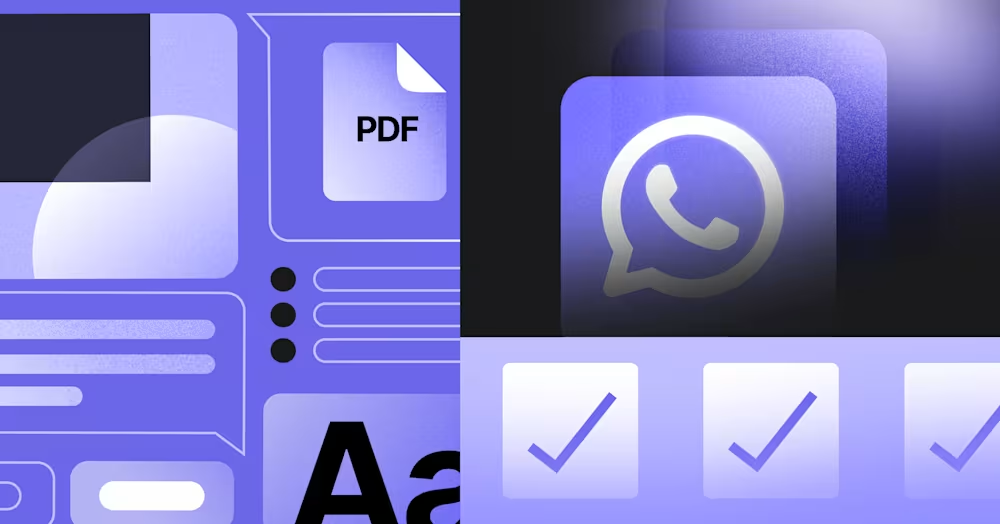
Mẫu tin nhắn WhatsApp: Hướng dẫn cách thực hiện với 13 ví dụ
Doanh nghiệp không thể gửi tin nhắn WhatsApp sau 24 giờ trừ khi họ sử dụng Mẫu tin nhắn WhatsApp. Tìm hiểu cách định dạng và gửi tin nhắn mẫu cùng các ví dụ.
![Hỗ trợ đàm thoại: Cách cải thiện trải nghiệm của khách hàng [Tháng 7 năm 2023]](https://assets2-proxy.respond.io/ph8r57dk1q9w/1fI3ZuMBKFxToVapTiIZlM/00fae236302cca135ea9f4c155f3a06e/concepts-conversational-support_ea2d5df650550735a61f42ef3065c5c1.png?q=70&fm=avif)
Hỗ trợ khách hàng là chìa khóa cho sự thành công của bất kỳ doanh nghiệp nào. Trước đây, hỗ trợ khách hàng thường chỉ mang tính giao dịch, có nghĩa là khách hàng sẽ liên hệ với doanh nghiệp khi họ gặp vấn đề và doanh nghiệp sẽ phản hồi bằng một giải pháp. Tuy nhiên, với sự phát triển của các ứng dụng nhắn tin, hỗ trợ khách hàng đã chuyển sang cách tiếp cận mang tính cuộc trò chuyện hơn. Trong bài viết này, chúng tôi sẽ thảo luận về khái niệm hỗ trợ khách hàng qua trò chuyện, cũng như những lợi ích, thách thức và cách triển khai phương pháp dịch vụ khách hàng qua trò chuyện với respond.io.
Thông thường, các công ty có cách tiếp cận giao dịch đối với hỗ trợ, tập trung vào việc giải quyết các vấn đề cụ thể của khách hàng. Như tên gọi đã chỉ ra, cách tiếp cận này chủ yếu mang tính giao dịch, có nghĩa là mục tiêu là giải quyết vấn đề của khách hàng nhanh chóng và hiệu quả nhất có thể.
Dịch vụ khách hàng giao dịch thường liên quan đến việc chỉ định cho khách hàng một phiếu hoặc số và cung cấp thông tin cụ thể, các bước khắc phục sự cố hoặc giải pháp cho vấn đề của khách hàng. Phong cách giao tiếp của các nhân viên hỗ trợ trong mô hình giao dịch là chính thức và chuyên nghiệp.
Dịch vụ khách hàng trò chuyện đề cập đến việc sử dụng các đại lý trò chuyện trực tiếp và công nghệ như phần mềm hỗ trợ cuộc trò chuyện để tạo ra một trải nghiệm mô phỏng các cuộc trò chuyện giữa người với người thay vì một loạt các tương tác tách biệt.
Nó liên quan đến việc tham gia vào các cuộc trò chuyện bằng ngôn ngữ tự nhiên với khách hàng để hiểu nhu cầu của họ, trả lời các câu hỏi và giải quyết các vấn đề của họ.
Vì tính chất của nó mang tính trò chuyện, các công ty thường cung cấp dịch vụ khách hàng trò chuyện chủ yếu qua các kênh nhắn tin tức thì. Hợp lý khi các đội hỗ trợ trò chuyện áp dụng cách tiếp cận hỗ trợ đa kênh nếu họ có mặt trên nhiều kênh.
Với cách này, khách hàng khi tương tác với họ sẽ có trải nghiệm nhất quán trên mọi kênh. Hãy cùng xem những lợi ích mà doanh nghiệp nên mong đợi từ dịch vụ khách hàng trò chuyện.
Trước hết, hỗ trợ cuộc trò chuyện cho phép trải nghiệm khách hàng được cá nhân hóa hơn. Thông qua việc sử dụng tự động hóa cuộc trò chuyện, các doanh nghiệp có thể đáp ứng các yêu cầu theo cách cảm thấy phù hợp với nhu cầu cụ thể của khách hàng.
Cách tiếp cận này có thể giúp xây dựng mối quan hệ chặt chẽ hơn với khách hàng, điều này rất quan trọng để thiết lập lòng trung thành và duy trì khách hàng.
Một lợi ích khác của hỗ trợ cuộc trò chuyện là nó cho phép thời gian phản hồi nhanh hơn. Nhờ có tự động hóa, khách hàng có thể nhận được câu trả lời nhanh chóng cho câu hỏi của họ. Và khi các nhân viên không có mặt, tin nhắn đi xa có thể được sử dụng để quản lý kỳ vọng về thời gian phản hồi.
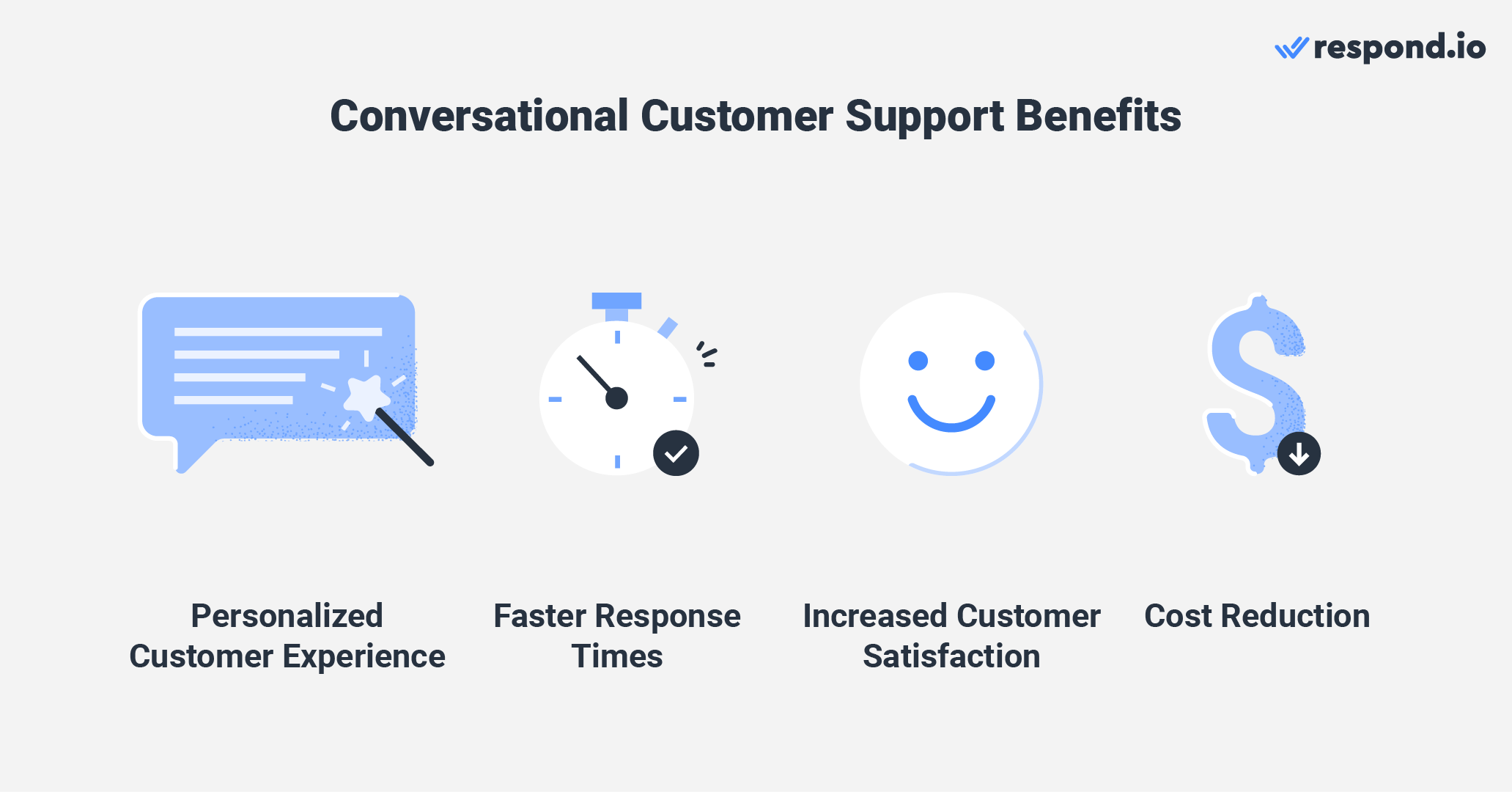
Điều này giúp cải thiện mức độ hài lòng của khách hàng, điều này rất cần thiết để duy trì mối quan hệ tích cực với khách hàng.
Ngoài ra, hỗ trợ cuộc trò chuyện cũng có thể giúp giảm chi phí cho các công ty. Bằng cách tự động hóa một số khía cạnh của dịch vụ khách hàng, các công ty có thể giảm sự phụ thuộc vào các đại diện dịch vụ khách hàng nhân sự, hoặc sử dụng nhân lực cho các công việc có giá trị cao hơn.
Tổng thể, hỗ trợ cuộc trò chuyện mang lại nhiều lợi ích cho cả các công ty và khách hàng. Với trải nghiệm cá nhân hóa hơn, thời gian phản hồi nhanh hơn và tiết kiệm chi phí.
Tiếp theo, chúng tôi sẽ hướng dẫn bạn qua câu chuyện của E4CC và cách mà họ đã sử dụng respond.io để cải thiện phương pháp hỗ trợ cuộc trò chuyện của mình.
E4CC, một nhà cung cấp đào tạo tiếng Anh cho người Mỹ Latinh đang tìm kiếm việc làm tại các trung tâm cuộc gọi, đã cải thiện phương pháp tiếp cận dịch vụ khách hàng theo hình thức đàm thoại bằng cách sử dụng respond.io. Trước đây, các nhân viên phụ trách dẫn dắt các liên hệ qua quy trình bán hàng.
Trên respond.io, các tác nhân E4CC đã sử dụng Tự động hóa quy trình công việc để hợp lý hóa quy trình định tuyến trò chuyện của mình. Các tác nhân cũng có thể phân loại các liên hệ bằng cách sử dụng Thẻ và giảm sự can thiệp thủ công vào quy trình bán hàng và hỗ trợ bằng cách sử dụng các tin nhắn tự động và quy trình định tuyến trò chuyện.
Việc này đã giúp khách hàng có thể lựa chọn chức năng bán hàng hoặc hỗ trợ và được kết nối ngay lập tức với một nhân viên phù hợp. Những cải tiến này đã giúp E4CC đạt được thời gian định tuyến trò chuyện nhanh gấp 3 lần.
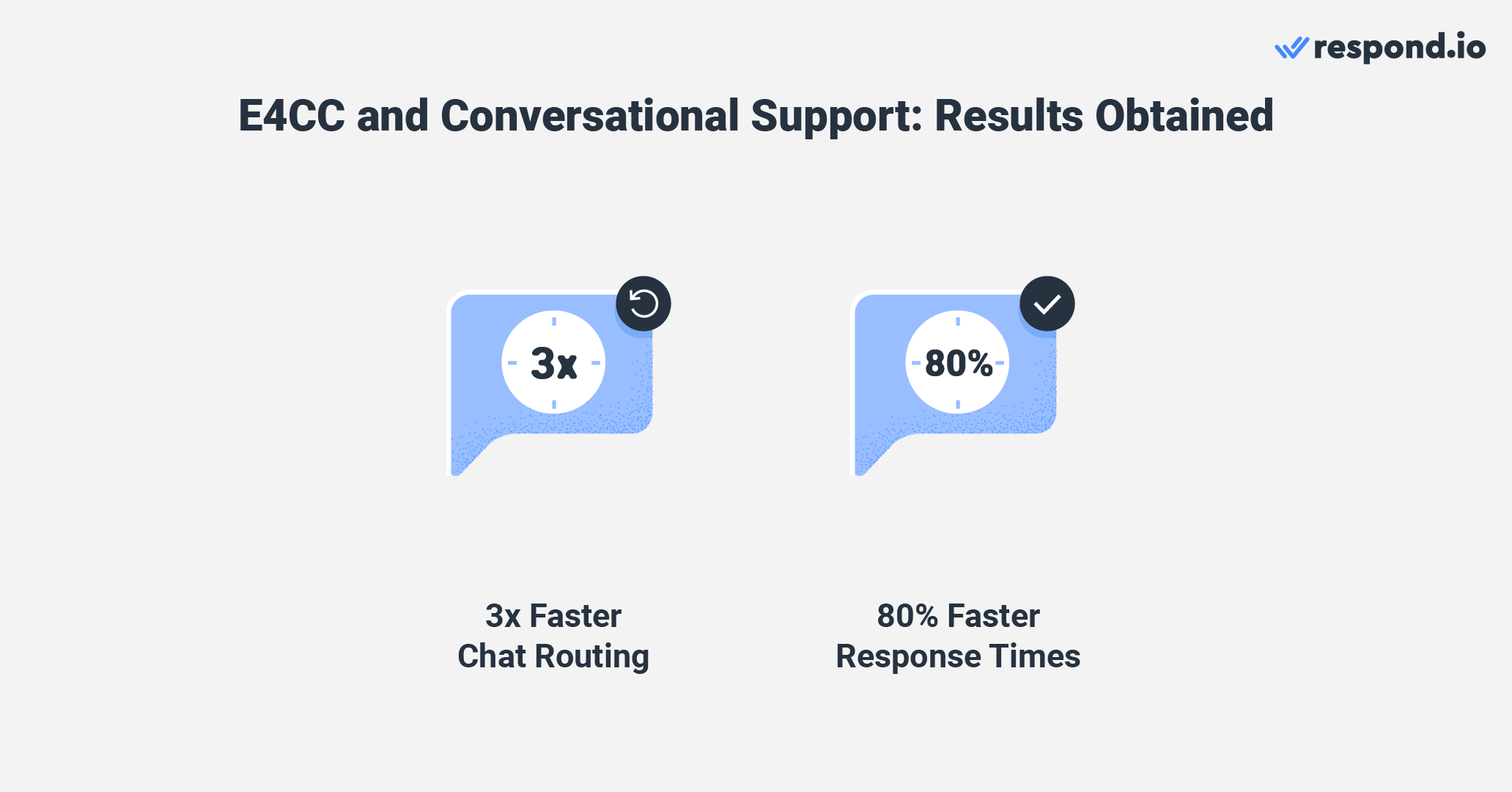
Công ty cũng nhận thấy sự cải thiện đáng kể về hiệu quả hoạt động, quản lý liên hệ và tốc độ chất lượng giao tiếp. Việc triển khai logic định tuyến đã giảm thời gian phản hồi đầu tiên xuống 80%.
Lúc đầu, hỗ trợ đa kênh có thể có vẻ gây khó khăn. Thực tế, có một số rào cản mà các doanh nghiệp có thể trải qua khi thay đổi phương pháp hỗ trợ từ giao dịch sang trò chuyện.
Chuyển đổi cuộc trò chuyện của khách hàng thành tăng trưởng doanh nghiệp với respond.io. ✨
Quản lý các cuộc gọi, trò chuyện và email ở một nơi!
Hỗ trợ khách hàng qua cuộc trò chuyện đi kèm với những thách thức riêng như quản lý nhiều kênh nhắn tin để trả lời các yêu cầu. Khi khách hàng liên hệ qua nhiều kênh khác nhau như WhatsApp, cuộc gọi hoặc tin nhắn SMS, việc quản lý tất cả các nền tảng này cùng lúc có thể trở nên khó khăn.
Nhiều kênh không hỗ trợ truy cập nhiều người dùng, dẫn đến giao tiếp không hiệu quả giữa nhóm hỗ trợ và thời gian phản hồi bị trì hoãn. Nhìn chung, các doanh nghiệp cần một giải pháp có thể mở rộng cho phép tích hợp nhiều nhân viên cần thiết mà không có giới hạn.
Ngoài ra, hầu hết các kênh nhắn tin áp đặt thời gian nhắn tin. Khi những điều này bảo vệ khách hàng khỏi spam, chúng lại đặt ra những hạn chế về thời gian mà các nhân viên hỗ trợ có thể nhắn tin cho khách hàng. Việc không thể phản hồi kịp thời có thể dẫn đến những cuộc trò chuyện tách biệt và khách hàng không hài lòng.
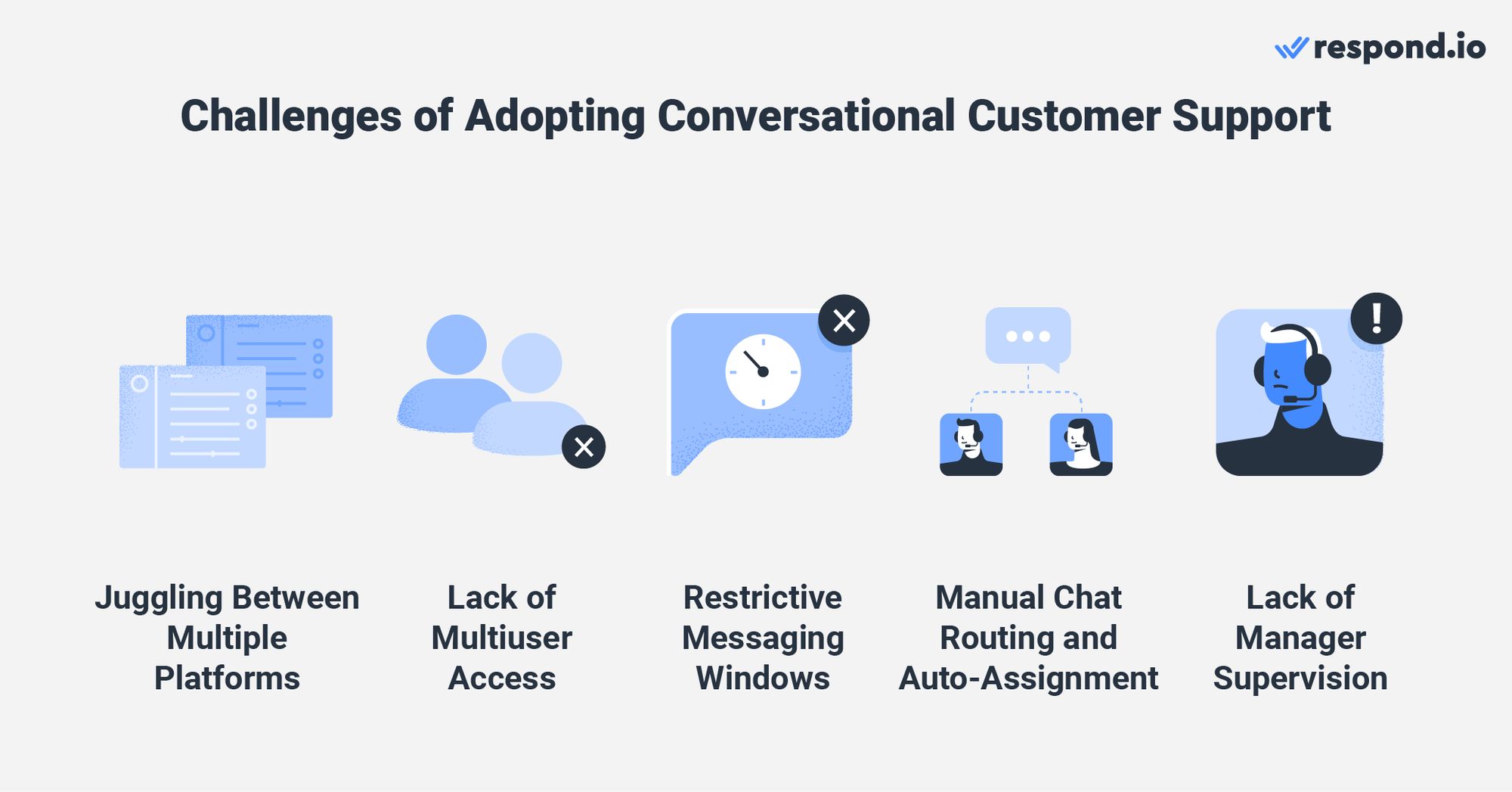
Một thách thức thường gặp khác là xác định bằng tay bản chất của các yêu cầu và chuyển cho các đội liên quan. Điều này có thể tốn thời gian và có thể dẫn đến lỗi trong việc chỉ định các yêu cầu cho đội phù hợp, khiến việc giải quyết bị trì hoãn.
Cuối cùng, việc giám sát chất lượng giao tiếp và hiệu suất của nhân viên có thể là một thách thức. Nếu không có giải pháp phù hợp, rất khó để đảm bảo rằng các nhân viên đang cung cấp dịch vụ hỗ trợ nhất quán và chất lượng cao cho khách hàng.
Điều này khiến việc xác định các lĩnh vực cần cải thiện trở thành một nhiệm vụ phức tạp. Sử dụng giải pháp phù hợp sẽ làm giảm hoặc thậm chí loại bỏ các vấn đề đã đề cập. Trong phần tiếp theo, chúng tôi sẽ giải thích cách mà respond.io có thể giúp.
Respond.io là phần mềm quản lý cuộc trò chuyện khách hàng được thiết kế với các tương tác khách hàng trò chuyện trong tâm. Dưới đây là cách mà respond.io giúp hỗ trợ cuộc trò chuyện trở nên dễ dàng cho đội ngũ khách hàng của bạn.
Là hộp thư đến đa kênh , respond.io cho phép các thành viên trong nhóm cộng tác hỗ trợ khách hàng trên nhiều kênh từ một nơi. Bất kể kênh nhắn tin nào mà khách hàng sử dụng, các doanh nghiệp có thể cung cấp cho họ trải nghiệm hỗ trợ liền mạch.
Tính năng Hợp nhất Liên hệ của respond.io giúp bạn hợp nhất nhiều hồ sơ khách hàng từ các kênh nhắn tin khác nhau thành một hồ sơ duy nhất.
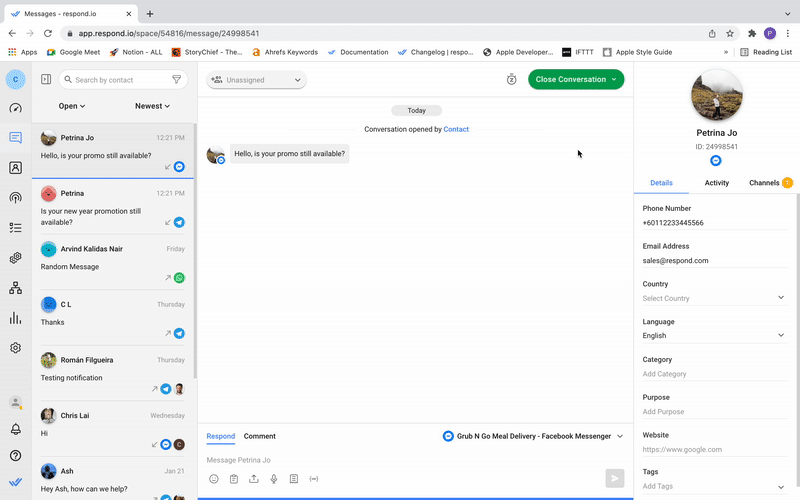
Điều này cho phép bạn nhận ra khách hàng trở lại trên bất kỳ kênh nào và đảm bảo rằng mọi thông tin của khách hàng đều được cập nhật và chính xác, giảm bớt sự lộn xộn trong Liên hệ và cung cấp cho các nhân viên cái nhìn toàn diện về khách hàng của họ.
Như đã đề cập, các cửa sổ nhắn tin là một trong những trở ngại chính khi cung cấp dịch vụ khách hàng trò chuyện. Nếu không có giải pháp phù hợp, các nhân viên hỗ trợ phải phụ thuộc vào khách hàng để mở lại cửa sổ nhắn tin bằng một tin nhắn mới, điều này không lý tưởng.
Respond.io cung cấp cho các doanh nghiệp một số phương pháp để tiếp tục cuộc trò chuyện với khách hàng trên các kênh nhắn tin khác nhau. Ví dụ: bạn có thể sử dụng respond.io để tạo, xác thực và lưu mẫu tin nhắn WhatsApp API và bắt đầu cuộc trò chuyện với khách hàng.
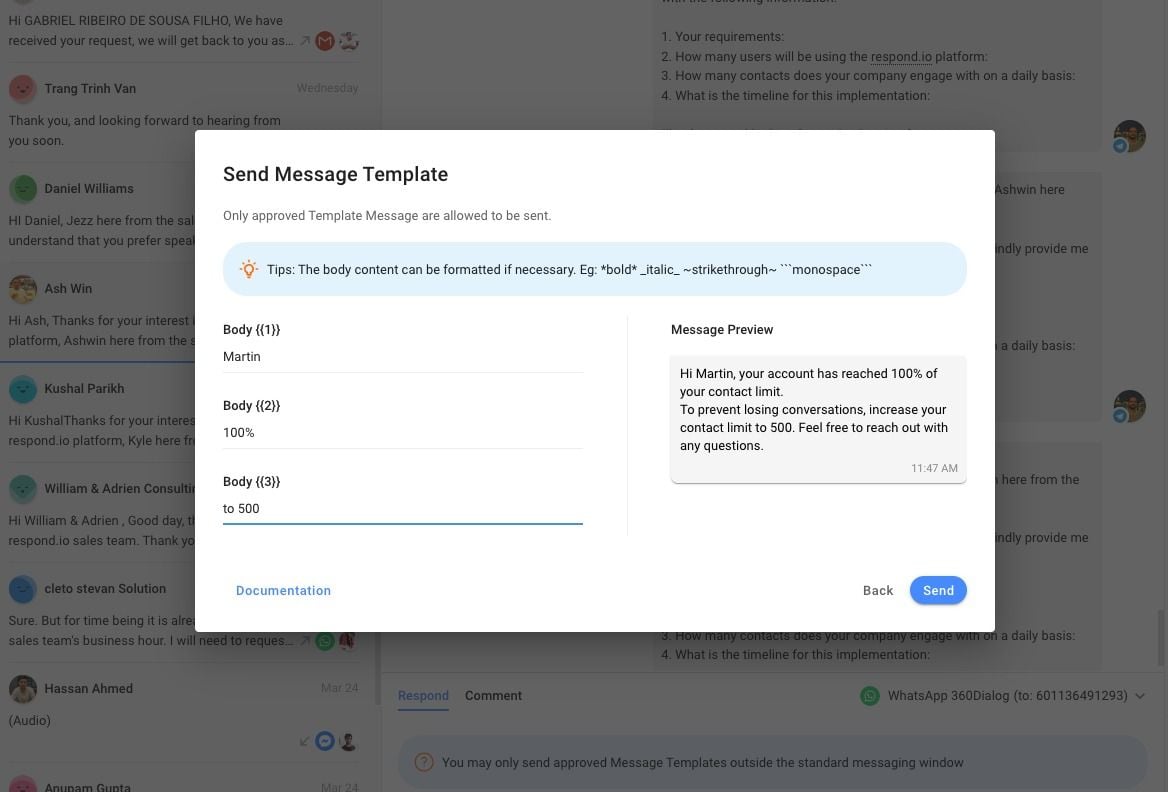
Nếu bạn lo lắng về cửa sổ nhắn tin của Facebook Messenger, cũng có một giải pháp cho vấn đề này. Respond.io hỗ trợ Thẻ tin nhắn, cho phép các nhân viên hỗ trợ bỏ qua cửa sổ cho một số trường hợp sử dụng.
Điều quan trọng nhất, respond.io là một trong những nền tảng được chọn hỗ trợ Nhãn Đại lý Nhân, mở rộng cửa sổ nhắn tin của Facebook Messenger từ 24 giờ lên 7 ngày.
Một số nhiệm vụ hỗ trợ rất tốn thời gian và làm tăng khối lượng công việc không cần thiết cho các đội ngũ tiếp xúc với khách hàng. Khi được tự động hóa, những quy trình này trở nên hiệu quả và nhất quán hơn, cho phép các nhân viên tập trung vào các nhiệm vụ quan trọng khác.
Respond.io's định tuyến trò chuyện và tự động chỉ định Quy trình làm việc giúp doanh nghiệp quản lý khối lượng lớn tin nhắn đến với ít hoặc không cần sự can thiệp của con người.
Các doanh nghiệp có thể đặt câu hỏi nhiều lựa chọn để định tuyến các cuộc trò chuyện dựa trên mục đích của chúng. Ngoài ra, sử dụng Nhãn để phân loại và định tuyến các khách hàng hiện tại, chẳng hạn như khách hàng VIP hoặc doanh nghiệp, đến các đội ngũ chuyên trách.
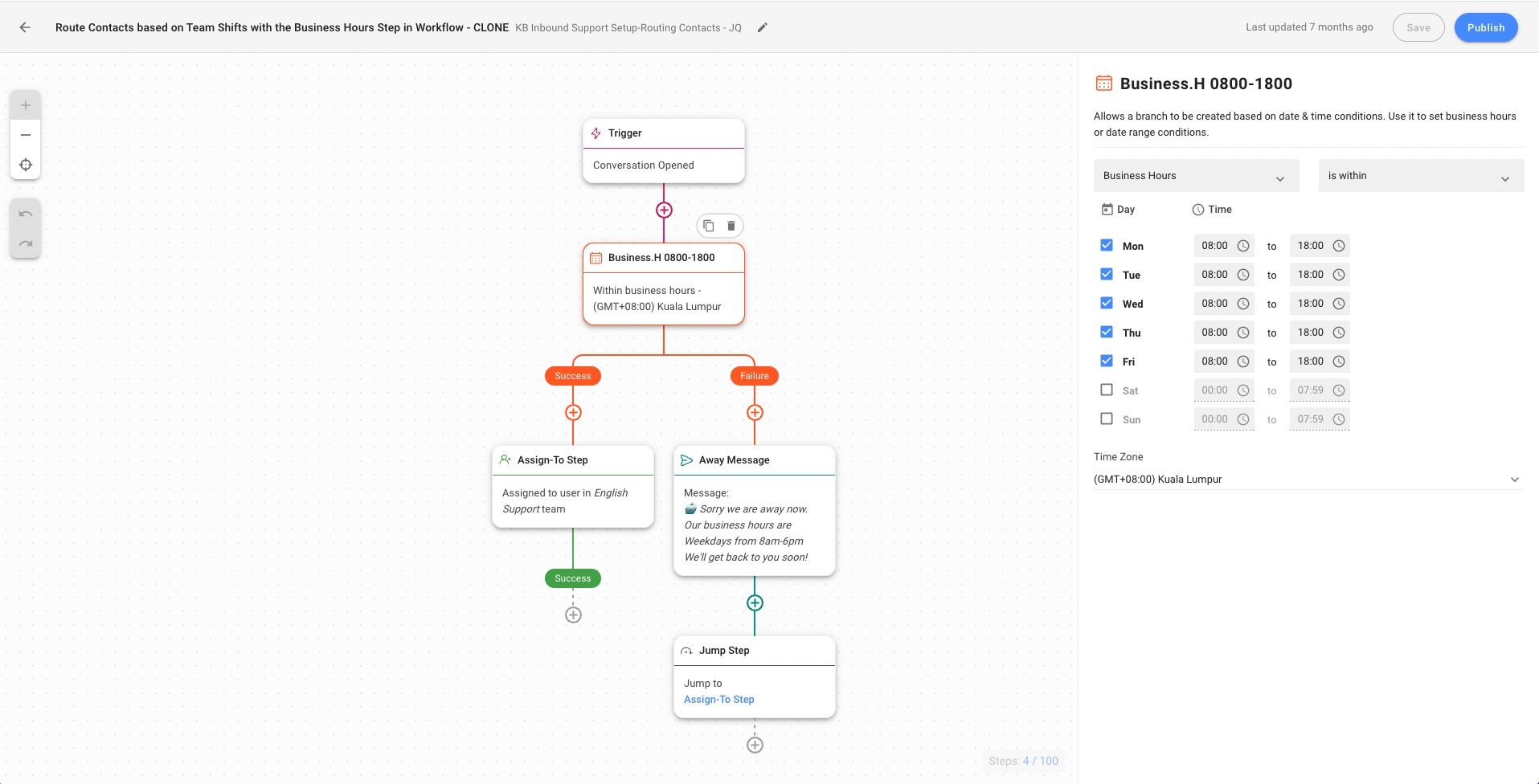
Sau khi các cuộc trò chuyện được chuyển đến đúng nhóm hỗ trợ, chúng có thể được chỉ định cho một nhân viên có sẵn hoặc một nhân viên cụ thể, tùy thuộc vào logic chỉ định của bạn.
Ngoài ra, respond.io tích hợp với CRM hỗ trợ của bạn. Điều này có thể đơn giản hóa quy trình làm việc hỗ trợ của bạn. Bằng cách cho phép bạn tự động hóa các tác vụ như tạo vé, chỉ định và theo dõi, tiết kiệm thời gian cho đội ngũ của bạn và giảm rủi ro lỗi.
Để đảm bảo sự thành công của chiến lược hỗ trợ khách hàng trò chuyện của bạn, các nhà quản lý cần giám sát tất cả các cuộc trò chuyện hỗ trợ trong bảng điều khiển đa kênh trung tâm.
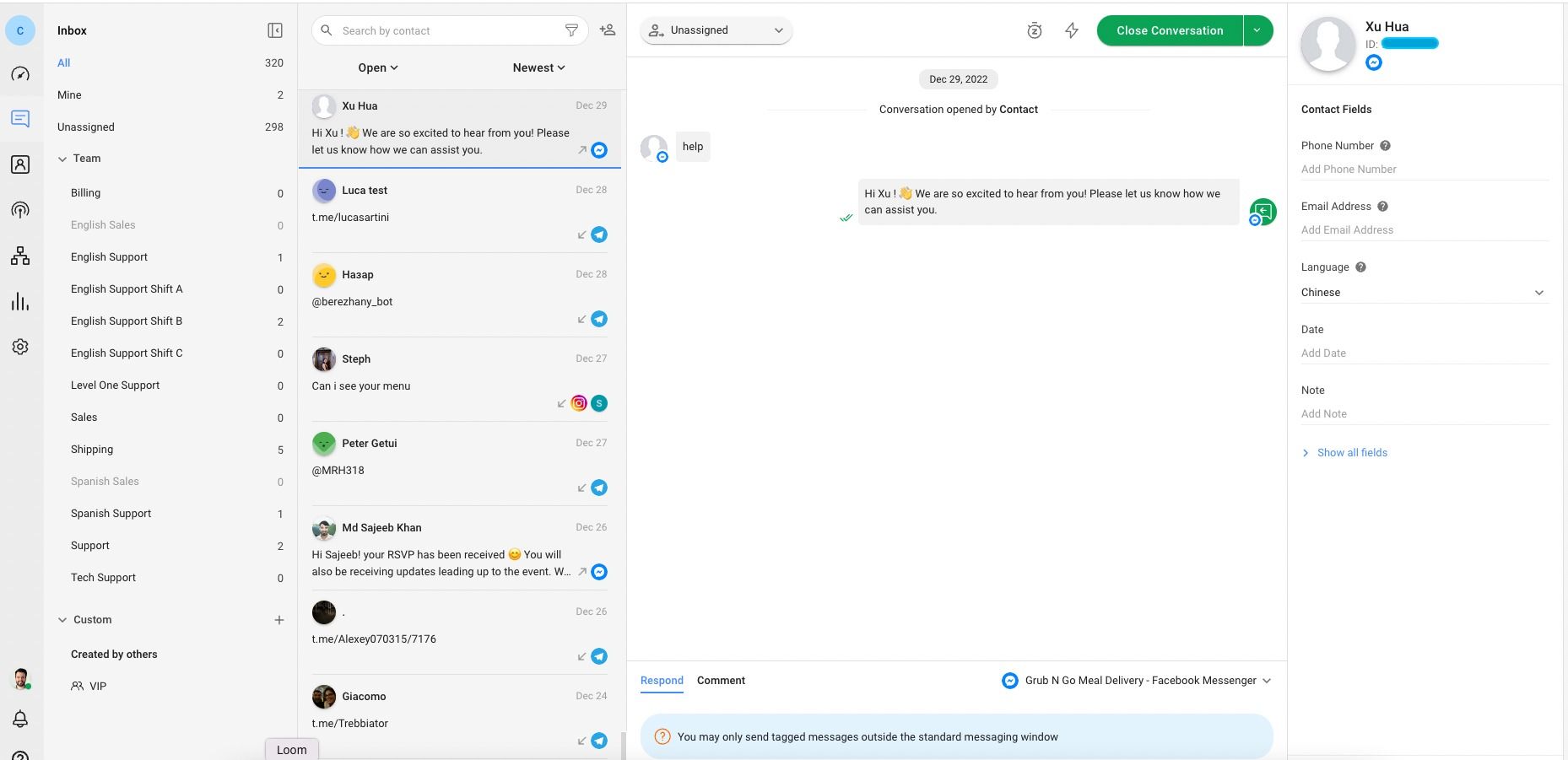
Respond.io cho phép bạn giám sát các cuộc trò chuyện trực tiếp trong thời gian thực, cung cấp những hiểu biết quý giá về các tương tác với khách hàng. Từ Bảng điều khiển respond.io , người quản lý có thể xác định xu hướng, theo dõi cảm nhận của khách hàng và đưa ra quyết định sáng suốt về chiến lược hỗ trợ.
Bởi vì các nhân viên hỗ trợ cuộc trò chuyện hướng tới việc tạo dựng những mối quan hệ lâu dài với khách hàng, việc đánh giá mức độ hài lòng mà khách hàng trải qua khi trò chuyện với các nhân viên là rất quan trọng.
Khảo sát CSAT là một trong những phương pháp phổ biến nhất để đánh giá mức độ hài lòng của khách hàng và có thể được thiết lập bằng quy trình làm việc respond.io.
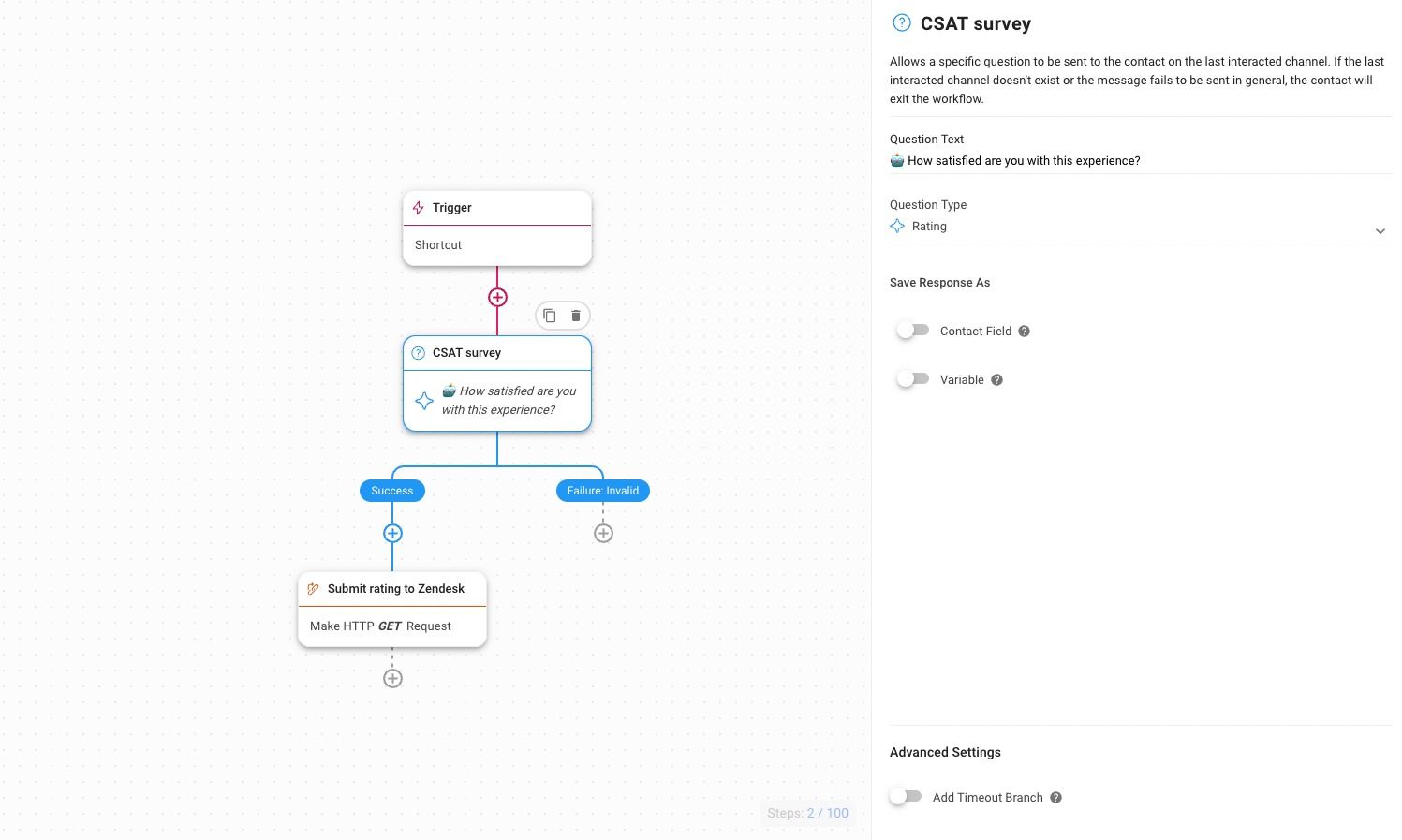
Một số doanh nghiệp chọn gửi tự động khảo sát CSAT mỗi khi một cuộc trò chuyện được đóng lại để thu thập thêm dữ liệu. Tuy nhiên, để tránh làm phiền những khách hàng thường xuyên hoặc lâu năm, doanh nghiệp cũng có thể chọn kích hoạt thủ công .
Tóm lại, các công ty hiện nay nhận ra những lợi ích mà dịch vụ khách hàng qua cuộc trò chuyện mang lại so với hỗ trợ giao dịch.
Mặc dù việc triển khai một chiến lược hỗ trợ cuộc trò chuyện đi kèm với những thách thức riêng, nhưng những thách thức này trở nên không đáng kể với sự giúp đỡ của một phần mềm quản lý cuộc trò chuyện khách hàng như respond.io.
Bạn có muốn đội ngũ khách hàng của bạn bắt đầu với hỗ trợ cuộc trò chuyện không? Hãy dùng thử respond.io miễn phí ngay hôm nay!
Chuyển đổi cuộc trò chuyện của khách hàng thành tăng trưởng doanh nghiệp với respond.io. ✨
Quản lý các cuộc gọi, trò chuyện và email ở một nơi!
Nếu bạn thấy bài viết này thú vị, đây là một số tài liệu bổ sung mà bạn có thể thích:
Román Filgueira, tốt nghiệp Đại học Vigo với bằng Cử nhân Ngoại ngữ, đã gia nhập nhóm respond.io với tư cách là Biên tập viên nội dung vào năm 2021. Román cung cấp những hiểu biết chuyên sâu về các phương pháp hay nhất để sử dụng ứng dụng nhắn tin nhằm thúc đẩy tăng trưởng kinh doanh.

Doanh nghiệp không thể gửi tin nhắn WhatsApp sau 24 giờ trừ khi họ sử dụng Mẫu tin nhắn WhatsApp. Tìm hiểu cách định dạng và gửi tin nhắn mẫu cùng các ví dụ.